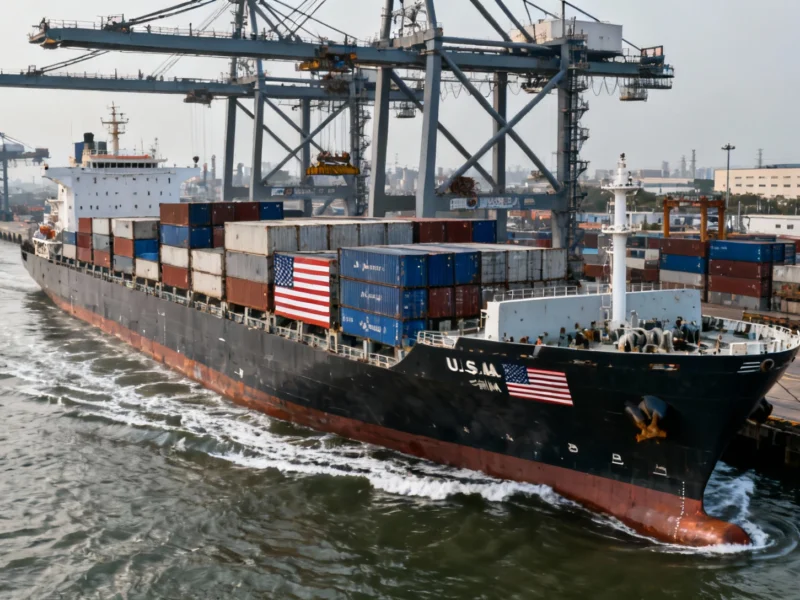As the United States-Mexico-Canada Agreement approaches its scheduled review next year, business leaders and policymakers face critical decisions about the future of North American trade. The agreement, which succeeded NAFTA and represents one of the Trump Administration’s signature achievements, now faces renewal talks amid global economic uncertainty and increasing tariff pressures on Canada and Mexico. According to recent analysis of the USMCA framework, the trilateral partnership supports nearly $2 trillion in annual trade, making its continuation vital for American economic interests.
Deep Economic Integration Makes Separation Impossible
The profound interconnectedness of North American economies makes any drastic reduction in trade relationships both economically damaging and practically unfeasible. “You can’t unscramble scrambled eggs,” noted a diplomat at last week’s North Capital Forum in Mexico City, capturing the reality of deeply integrated supply chains and manufacturing networks. The three nations have built complementary economic systems where, as industry experts note about North American integration, separation would disrupt decades of carefully developed trade relationships and investment patterns.
This integration extends across multiple sectors, creating what Enrique Perret, Director of the US Mexico Foundation, describes as “one deeply interwoven system” rather than three separate markets. At the North Capital Forum, Perret emphasized that Mexico’s role extends far beyond traditional sectors like tourism and agriculture, positioning the country as a hub for advanced manufacturing, technology, and essential industries that support American economic growth.
Critical Role of Mexico in US Supply Chains
Despite Mexico’s integral position in American economic networks, public perception of trade with the southern neighbor remains disproportionately negative. This disconnect poses significant challenges as supply chain experts emphasize Mexico’s crucial role in maintaining competitive American manufacturing and retail operations. The food sector particularly illustrates this dependency, with major US retailers relying on Mexican imports to maintain consistent product availability.
Walmart’s operations demonstrate this critical relationship, where according to data from grocery industry analysis, 60% of the company’s $276 billion in US sales come from food products. The retail giant depends heavily on cross-border agricultural trade to stock shelves year-round, with Mexico providing essential products during seasons when domestic production cannot meet consumer demand. This relationship exemplifies the complex, mutually beneficial trade networks that have developed under decades of North American trade agreements.
Energy and Clean Technology Opportunities
Beyond traditional manufacturing and agriculture, North American energy cooperation represents a significant growth area with substantial potential benefits for all three nations. Recent commentary from industry experts note the potential for strengthened energy partnerships that could enhance regional security and economic competitiveness. Meanwhile, according to recent analysis of clean energy trends, coordinated North American approaches to renewable energy development could position the region as a global leader in emerging technologies.
The potential for growth in these sectors is substantial, with Perret estimating that strengthened North American cooperation could yield $3 trillion in trade within the next five years. This growth would depend on developing “stronger supply chains, complementary labor markets, and shared priorities in food and energy security” across the three nations.
Agricultural Dependencies and Seasonal Supply
The agricultural sector particularly illustrates the practical realities of North American economic integration. American consumers have grown accustomed to year-round availability of fresh produce, a convenience made possible by complementary growing seasons and efficient cross-border supply chains. As research on agricultural supply chains demonstrates, these networks have become so sophisticated that disruption would immediately impact supermarket shelves and consumer prices.
This dependency extends beyond simple import-export relationships to deeply integrated production systems where, as agricultural experts emphasize, farmers and producers in all three countries coordinate planting, harvesting, and distribution to maximize efficiency and minimize costs. The result is a truly North American agricultural system that benefits consumers across the region while supporting rural economies in all three nations.
Business Community Engagement Critical
With the Office of the U.S. Trade Representative seeking public comments on USMCA before November 3, the private sector has a crucial opportunity to influence the agreement’s future direction. Business leaders representing companies with vested interests in trilateral trade can provide concrete examples of how the agreement supports American jobs and economic growth. This input is particularly important for countering negative perceptions about trade relationships that don’t reflect economic realities.
The engagement opportunity comes at a critical moment for United States trade policy, as policymakers weigh competing priorities in an increasingly complex global economic environment. Business input can help ensure that American companies—particularly those that serve as major job creators—have their perspectives incorporated into any revised agreement.
Path Forward for North American Trade
As renewal negotiations approach, several key priorities emerge for strengthening the agreement:
- Supply chain resilience: Enhancing coordination to mitigate disruptions and reduce dependencies on distant suppliers
- Energy integration: Developing complementary energy policies that leverage each nation’s strengths and resources
- Regulatory alignment: Reducing unnecessary regulatory differences that increase business costs
- Digital trade: Updating provisions to reflect the growing importance of e-commerce and data flows
- Workforce development: Creating complementary labor market strategies that address regional needs
Successfully navigating the renewal process will require acknowledging the reality that North American economies have become fundamentally integrated over decades of close partnership. Rather than attempting to reverse this integration, policymakers should focus on strengthening the frameworks that support this mutually beneficial relationship while addressing legitimate concerns about specific sectors or practices.
The upcoming review represents not just a procedural requirement but a strategic opportunity to reinforce one of the world’s most successful regional trade partnerships. With thoughtful engagement from business leaders and pragmatic approaches from policymakers, the USMCA renewal can build on past successes while positioning North America for continued economic leadership in an increasingly competitive global landscape. For additional coverage of international trade policy developments, see our related analysis of emerging markets and global supply chain trends.



